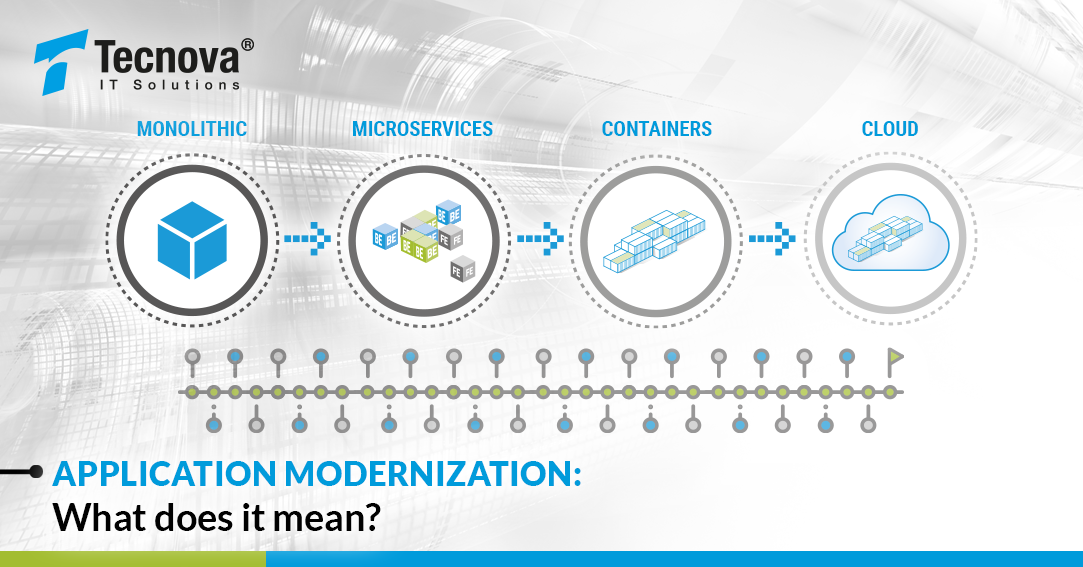APPLICATION MODERNIZATION: What does it mean?

The pandemic has stimulated the demand for digital transformation among organizations, and with it the need for an agile and scalable IT environment in order to meet the growing needs of customers. However, meeting these needs is diluted if these companies use a monolithic software architecture. In many organizations digital transformation will only be an idea if it is not combined with an intention to modernize applications.
From Tecnova we say: “organizations must intensify the digitization of their processes and adopt the modernization of applications, so they will be more competitive”.
Next, in this article, you will know the essentials about application modernization.
How is application modernization defined?
According to TechTarget, application modernization “is the refactoring, change of purpose or consolidation of the programming of legacy software, in order to align it with current business needs.”
To that definition, Gartner adds that, “modernization options include: re-platform, re-hosting, recoding, rearmament, reengineering, interoperability, replacement. As well as changes in the architecture of the application”.
En simples palabras, la modernización de aplicaciones es el desarrollo de soluciones informáticas con métodos, tecnologías y arquitecturas actuales.
How can we understand application modernization?
Application modernization is dividing legacy applications into their individual functions so that each function runs on its own with the help of containers. This makes work agile, scalable, faster to implement, and independent.
To understand application modernization, we will break down its components:
| Components | Inherited Modern | ||
| Architecture | Monolithic | SOA | Microservices |
| Infraestructure | Physical | Virtual Machines | Cloud |
| Delivery | Waterfall/Scrum | Agile | DevOps |
Application modernization is not just about transforming business processes into “digital”, but about leveraging legacy applications to create services and microservices with individual functions and host them on elastic infrastructure such as a hybrid or public cloud.
True application modernization exercises range from monolith architecture to microservices. Also the migration of physical servers to Cloud Infrastructure and the movement of the delivery method from waterfall to DevOps. Some organizations implement them slowly due to budget constraints, other companies opt for a full overhaul. Whichever form an organization chooses, they must consider and align these three critical aspects of their IT infrastructure.
Top benefits of application modernization
Infrastructure cost / scalability: Application modernization, through the cloud, offers a pay-per-use model which allows companies to scale when they need to manage a higher workload at a lower cost.
Agility: Applications no longer depend on software components and services from the operating system and / or third parties thanks to containers. Developers and operations managers have fewer restrictions when designing, implementing and deploying software, increasing the delivery rate of productive software.
Reducing the complexity of the software: With microservices, on the other hand, it is easier to update parts or modules by reducing the complexity of the software from a large monolith to smaller and more manageable pieces. Each function or microservice within the application can be assigned to teams with the respective know-how. This leads to room for experimentation and innovation, thus accelerating the growth of processes.
Security and Resilience: Hackers view legacy applications as straightforward targets. There are cases where legacy applications can no longer be updated. That may be the opportunity for hackers to attack.
The steps for application modernization
Techbeacon suggests that to help organizations on their journey to application modernization, the following should be done:
- Ask the right questions. Why modernize an app now? Who benefits and what new opportunities are opening up?
- Assess where you can find the skills you need to start refactoring or migrating an application.
- Consider whether your modernization effort should include migrations to the cloud. Many companies today do.
- Determine the metrics to meet the development goal.
- Assess the risks of each option, as applications are often critical to an organization’s most important business processes.








